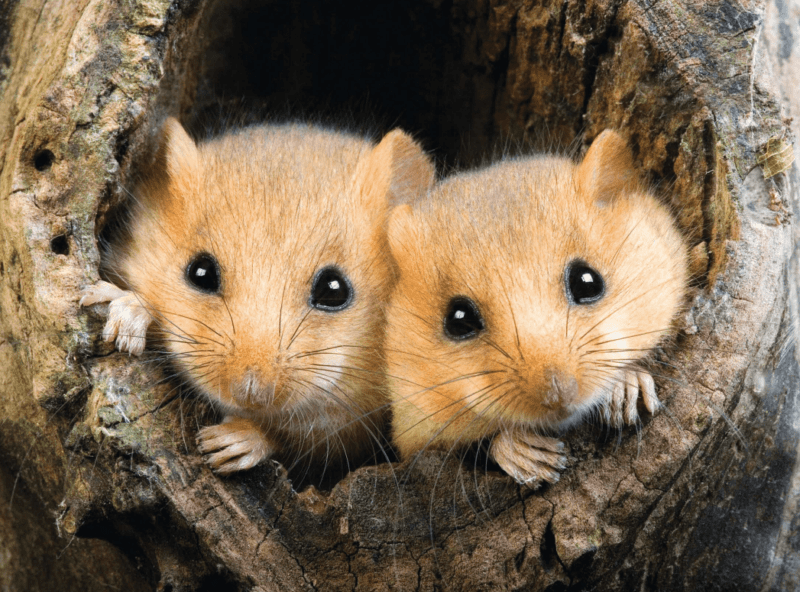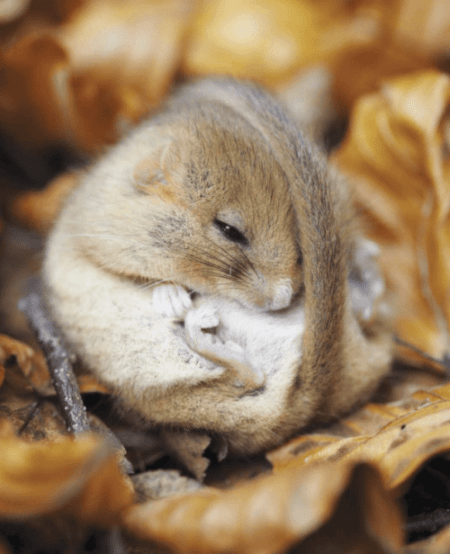
By Jim Knox
They inhabit literature, language, and culture. Creatures we have all heard of—or believe we know—whose true identities and natural histories prove elusive. Familiar yet mysterious, they dwell on the fringe of recollection and understanding. For every Springhare there is a Skunk bear. For every Timberdoodle, a Siren. Yet there are few animals simultaneously more familiar yet less known than the dormouse. Penned into literary history by Lewis Carroll, the dormouse is assumed to be a singular creature. While its British embodiment is the Hazel dormouse, Muscardinus avellanarius, the dormouse is not one, but 29 known species ranging across Europe, Asia, and Africa.
So, exactly what are these small nocturnal creatures? Dormice are mouse-like rodents with long furry squirrel-like tails and almost universal familiarity. Typically, brownish above and whitish below, and ranging in size from 2.5-8 inches in length and from .5-6.5 ounces in weight, they occupy the ecological roles of both mice and squirrels.
As omnivores, dormice fuel their tiny bodies with fruit, seeds, flowers, nectar, berries, pollen, and insects. Ever opportunistic, dormice readily target protein-rich insect prey as well as energy-rich nuts—especially Hazelnuts—to stoke up on lifesaving fat to get them through extended periods of hibernation.
It is the dormouse’s name which alludes to this hibernation, which is nothing short of extraordinary. The name is likely derived from the French and Spanish verb, dormir—to sleep, or possibly from the French feminine form, dormeuse—sleeper. It is this hibernation which gives the dormouse a keen edge on the competition. In temperate climes, after undergoing hyper-foraging to bolster its energy reserves, the dormouse will either appropriate a bird nest or construct one of its own (in the trees or hidden on the ground) and settle in for a long winter’s sleep of six months or more. In fact, the record hibernation for a Hazel dormouse was an astounding 11 months. Yet the dormouse has a failsafe plan, waking up during especially lengthy hibernation cycles for a midwinter snack.

With over one third of the planet’s 6,500 (and counting) mammal species belonging to the Order Rodentia, rodents have evolved to fill nearly all terrestrial niches on the planet’s continents, except Antarctica. These remarkable creatures share a common trait of continuously growing incisors and highly adaptable behaviors honed over millions of years. In the case of dormice, that pedigree has been refined over more than 30 million years in Mother Nature’s Research and Development Department!
As with so many of the planet’s most successful creatures, there is more to the little dormouse than meets the eye. Among the dormouse’s suite of physical adaptations that mark it as an exceptional climber are its sharp claws, strongly grasping toes, and balancing tail. These confer rapid climbing ability, sure grip, and balance at the tips of shoots and twigs, enabling the dormouse to evade weasels, foxes, and other mammalian carnivores. It is not simply a host of physical adaptations that aid these petite mammals, their behavioral adaptation of strong family bonds consistently runs in their family tree. As creatures who live in families, their ultra-keen senses of sight, hearing, smell, and touch (by means of their long whiskers) are amplified—conferring benefit to each individual in the family group.
Among the dormouse’s other innate traits is surprising longevity for a rodent of its size. Whereas typical House mice and their wild cousins may live 1-2 or sometimes 3 years, the dormouse frequently lives up to 5 years. In the case of the Edible dormouse (its actual and unfortunate name), an astonishing life span of 13 years has been recorded, making it the subject of scientific longevity research as well as defying the odds, and our understanding of what is possible.
So, what is it we can learn from the dormouse? Most immediately, we can study these small creatures more closely. Affected by habitat and climate disruption, the more we can protect the world around them, the more we can benefit from the knowledge they offer us.
Hidden but not dormant, we all possess special abilities. Like the dormouse, we are often familiar to those around us, yet we are only partially understood. To be most effective, we may leave our abilities in reserve and reveal our innate talents, skills, and teamwork when we need them most. We can look to our families for support and offer our support in turn to help us negotiate the rigors of the world around us. Employing the ultimate dormouse strategy for success, we can reserve our energies to gather our strength and explore the world with keen eyes for the opportunities we discover—together.
Jim Knox serves as the Curator of Education for Connecticut’s Beardsley Zoo where he directs education and conservation programming. A Member of The Explorers Club, Jim enjoys sharing his passion for wildlife with audiences in Connecticut and beyond.




